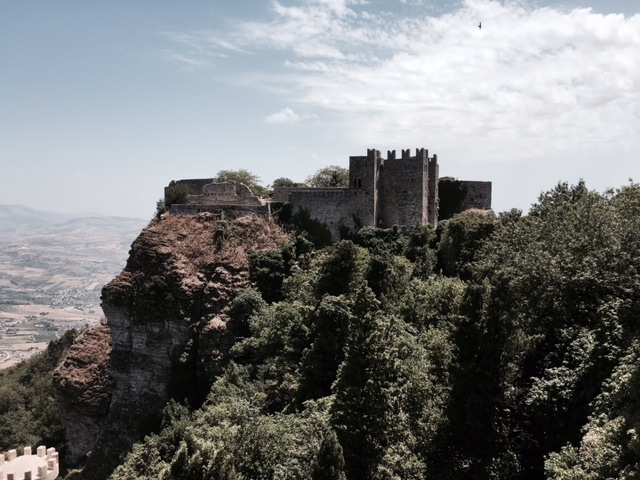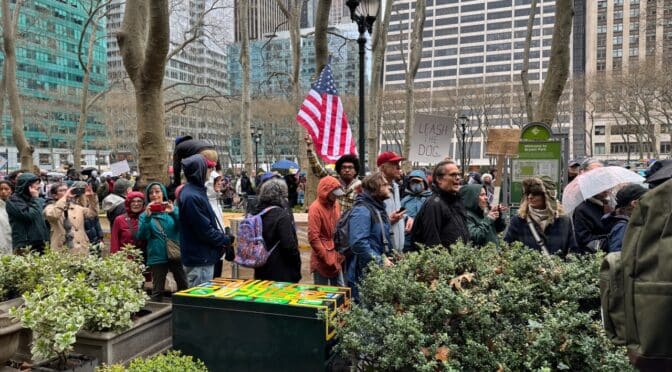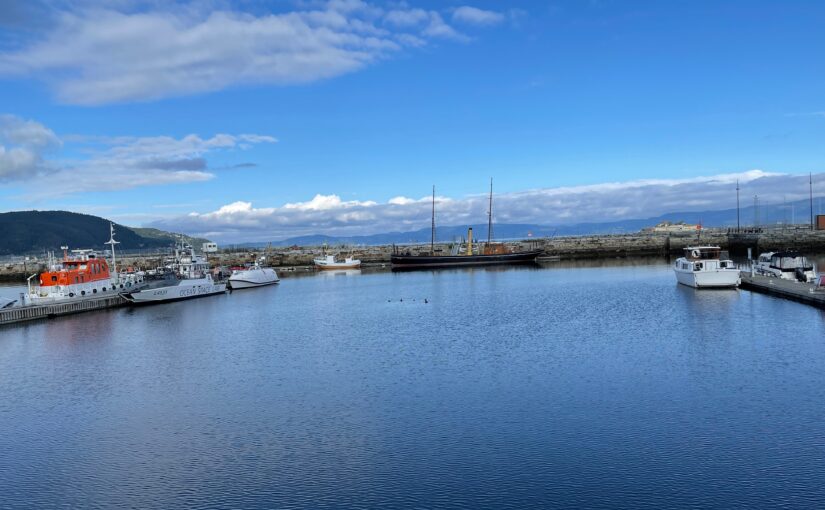by Nick Taylor and Barbara Nevins Taylor
Sicily opens a window into history and envelops you in its tumultuous past. But the island also offers a surprisingly current vibe, great food, warm hospitable people and an opportunity to indulge in romance.
On our fifth day in Sicily, we headed to Piazza Armerina because it’s near the Villa Romana del Casale. This 4th century Roman villa boasts elaborate mosaics that were preserved for centuries by being buried in a landslide. But the town offers some attractions of its own, as we learned negotiating its steep streets to the B&B where we would spend the night.
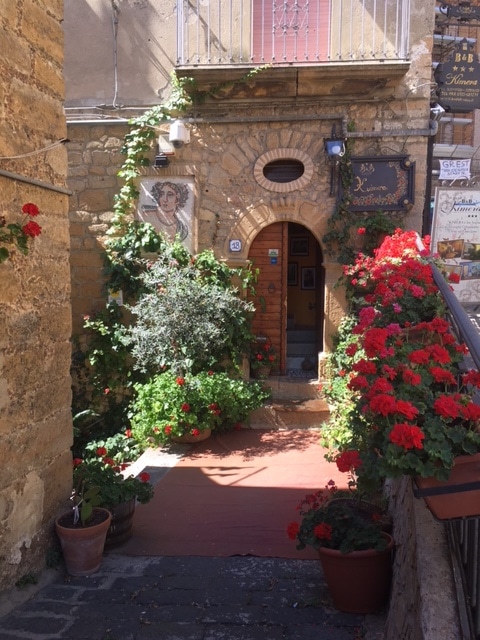
The entrance to B&B Kimera. Photo by ConsumerMojo.com
Barbara had found B&B Kimera online. It nestled in a cluster of buildings near what must have been the highest point in Piazza Armerina behind the town’s massive Baroque cathedral.
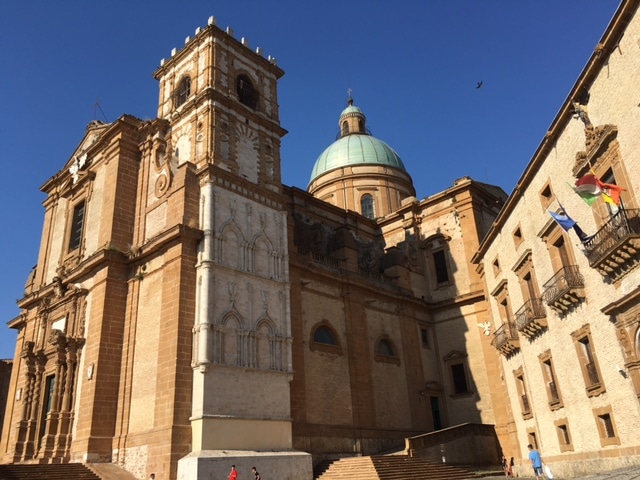
Rita Chiaramonte, the enthusiastic owner, greeted us effusively and asked us to choose between a room in the main building off the lobby and one in its own little house. We picked the main building and her husband Giuseppe brought our bags in from the car.
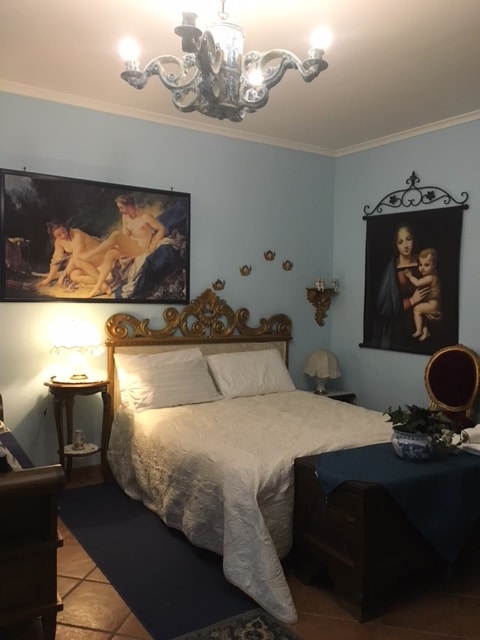
Our room at the B&B Kimera in Piazza Amerina, Sicily. Photo by ConsumerMojo.
The lovely room with elaborate furnishings made us feel as though we were invited to stay in a relative’s home.
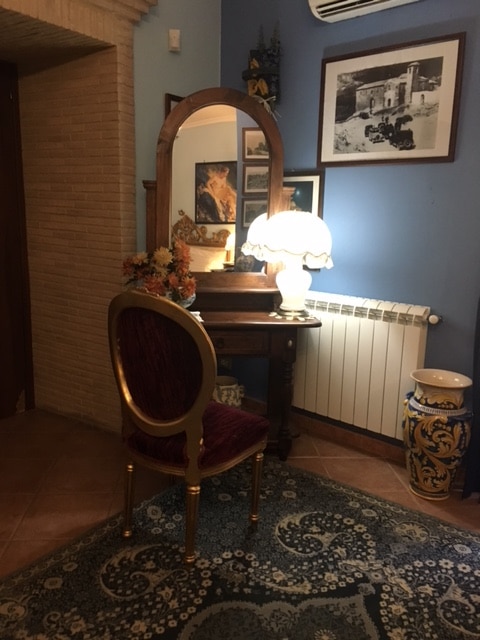
Lovely details in the room at B&B Kimera. Photo by ConsumerMojo.com.
Eager to stretch after a long ride over the Hyblaean mountains though Ragusa and Modica, we walked down Via Cavour to the square that fronted on the town hall, the Comune di Piazza Armerina.
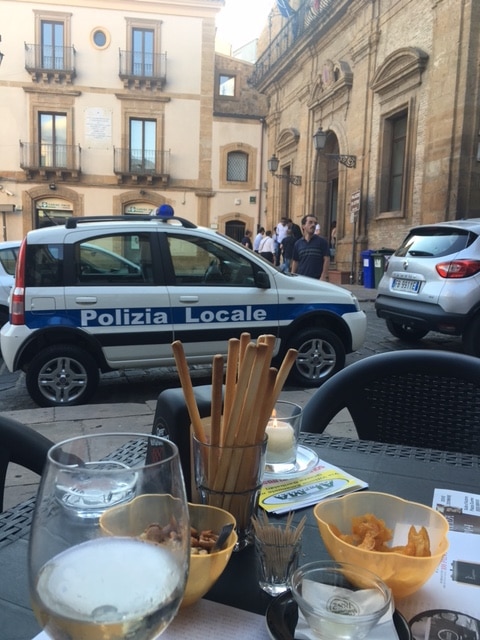
Bird’s-eye view of Piazza Armerina city hall from a cafe. Photo by ConsumerMojo.com
While we sipped white wine and munched breadsticks, nuts, chips and olives at an outside table, fancy cars delivered men in suits and uniforms and well-dressed women to a meeting at the town hall. Barbara’s journalist’s curiosity propelled her to ask one of the participants what was going on. The get-together of “a commercial federation,” she was told.
After an early evening nap, we took Rita’s recommendation and headed back down Via Cavour to the Ristorante La Tavernetta. The restaurant, with eight tables and a TV over a small bar alternating between a game show and a soccer match, filled up with locals. We soon found out why.
The “Specialita di Pesce” on its card told us that even inland, fish dominates Sicilian menus. We ordered a bottle of the local vino bianco. Barbara started with spaghetti con vongole and Nick chose the octopus salad. Her dish surpassed any spaghetti with clams we’ve had anywhere, ever. We both ordered grilled sea bream for our mains. The fish arrived blackened on the outside and moist and tender inside.
We gushed over the food as we ate. When we asked the chef how he cooked the fish so perfectly, he showed us the kitchen’s grill — a flat cast iron slab on top of a gas stove. “Lento, lento,” he said, demonstrating how he turned the fish over and over to get its blackened exterior and delicious interior texture.
We slept with the window open. Sometime in the middle of the night, I heard a thump, beating wings, and the chortle of a pigeon at the unbarred window. When I went to close the window Barbara woke up and asked what was going on. “Pigeon,” I said. Foggy with sleep, all she heard was, “…trying to break in.” When she realized what happened, her laughter at my heroic defense of the home front from the single bird invasion threatened to wake all of Piazza Armerina. We slept the rest of the night with the air conditioner on.
The next morning — now it was Friday, July 8 — I found Grazia, a young woman, helping Rita set up breakfast.

Our host Rita Chiaramonte and her assistant Grazia at the charming B&B. Photo by ConsumerMojo.com
They put out a lavish spread of prosciutto, salami, mortadella, cheeses and an assortment of breads in addition to croissants, with and without cream. But we disappointed them by sticking to caffe Americano, yoghurt and croissants. Experience taught us that big breakfasts and travel don’t always mix well.
The young couple at the breakfast table next to us had been at the Ristorante La Tavernetta the night before. They were speaking English and Italian, and I (Nick) told them we had noticed last night that they actually talked to each other instead of burying their noses in their cell phones. That started a conversation. It turned out that he was Sicilian and taught Italian at a university in the north of England. She was Austrian and taught German at a London university.
Like all other other European and Australian tourists we had talked with — we’d met no other Americans so far — they wanted to know how Americans could possibly take Donald Trump seriously. “How could they vote for him?” they asked. We talked about the anxieties of working people that fueled the Brexit vote and their similarity to the anger and fear that motivate Trump’s voters.
When we packed up and paid our bill, we rated B&B Kimera a bargain at less than seventy euros including VAT. We said goodbye to Rita and headed toward Villa Romana del Casale.
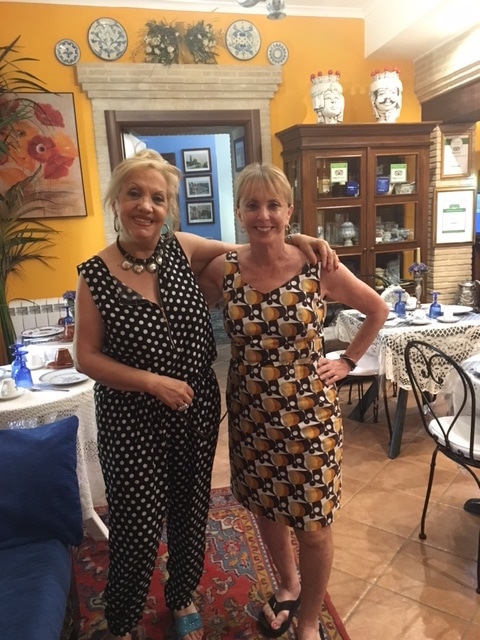
This UNESCO World Heritage site is one of the first places you read about when you start to plan a trip to Sicily. It’s near the middle of Sicily and reachable in two hours or less from almost anywhere. From Piazza Armerina it’s about three kilometers and the short distance is so well-marked Nick made only one wrong turn.
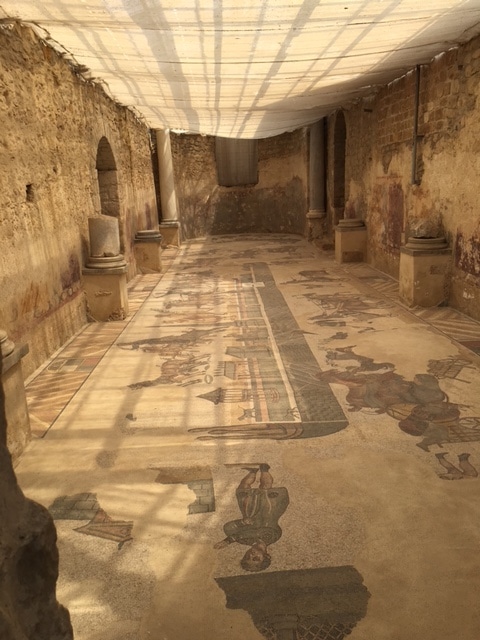
We decided against joining a group tour or hiring a guide. Cards at the many viewing sites explain how the villa worked. It’s thought to have been the center of a large agricultural complex or latifundium. The Roman owner, who ranked among the senatorial or perhaps the royal class, lived and conducted business there. One sign of his status was that he and his family lived on the north side of the villa in the summer and moved to its south for the sun in the winter months. The place was technically sophisticated for its time, with heated bathing areas and running water to carry away waste.
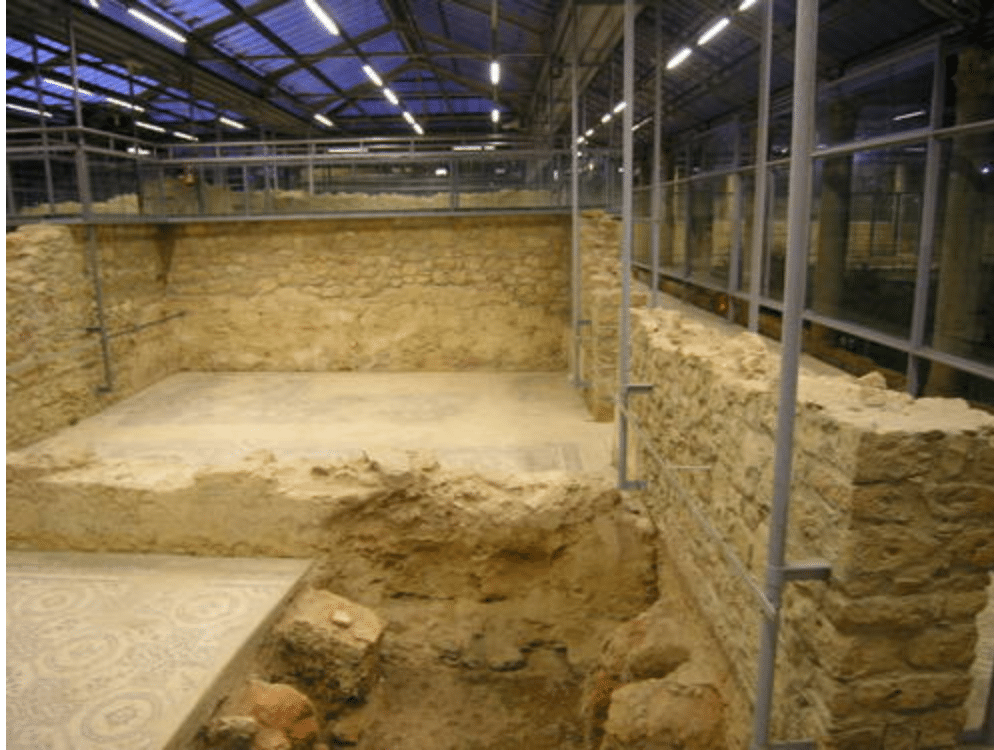
But viewing the bathing areas along the outside of the villa was just a run-up to the main attraction.
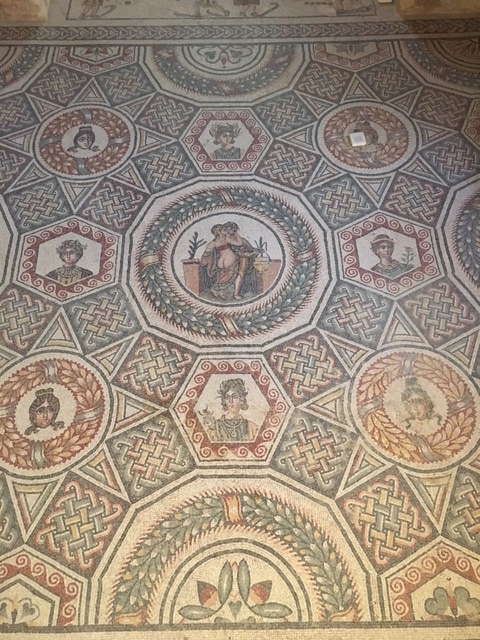
We’ve seen lots of Roman mosaics in our travels. The Romans made art of tiny colored tiles almost everywhere they went, including for example in Israel and Istanbul. But nothing had prepared us for the extent and variety of these, probably because it’s the largest surviving collection in the world.
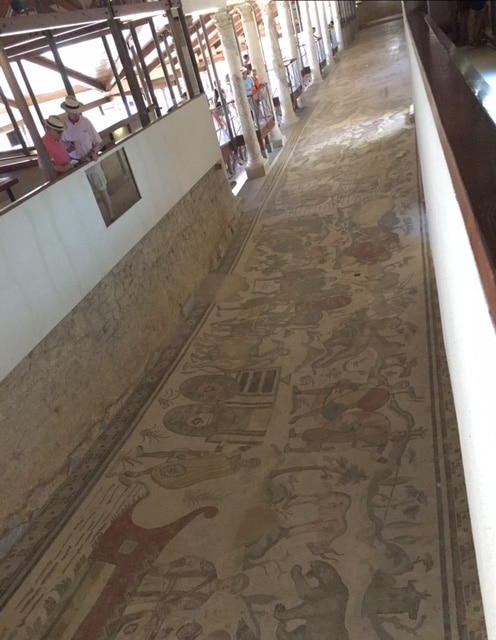 Long Floor Mosiac Villa Romana del Casale, Sicily. Photo by ConsumerMojo.com
Long Floor Mosiac Villa Romana del Casale, Sicily. Photo by ConsumerMojo.com
The storytelling on the floors and walls takes the breath away. The exquisitely rendered mosaics, some as long as 80 feet, include scenes of Roman life and myth — hunts, exotic animals, warriors and giants, and the famous “bikini girls.”
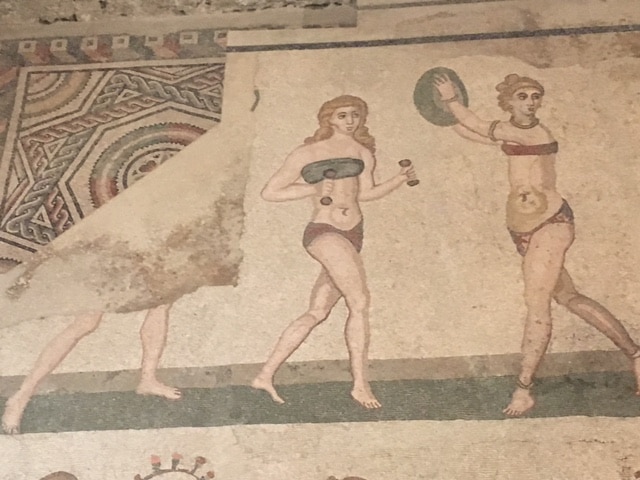
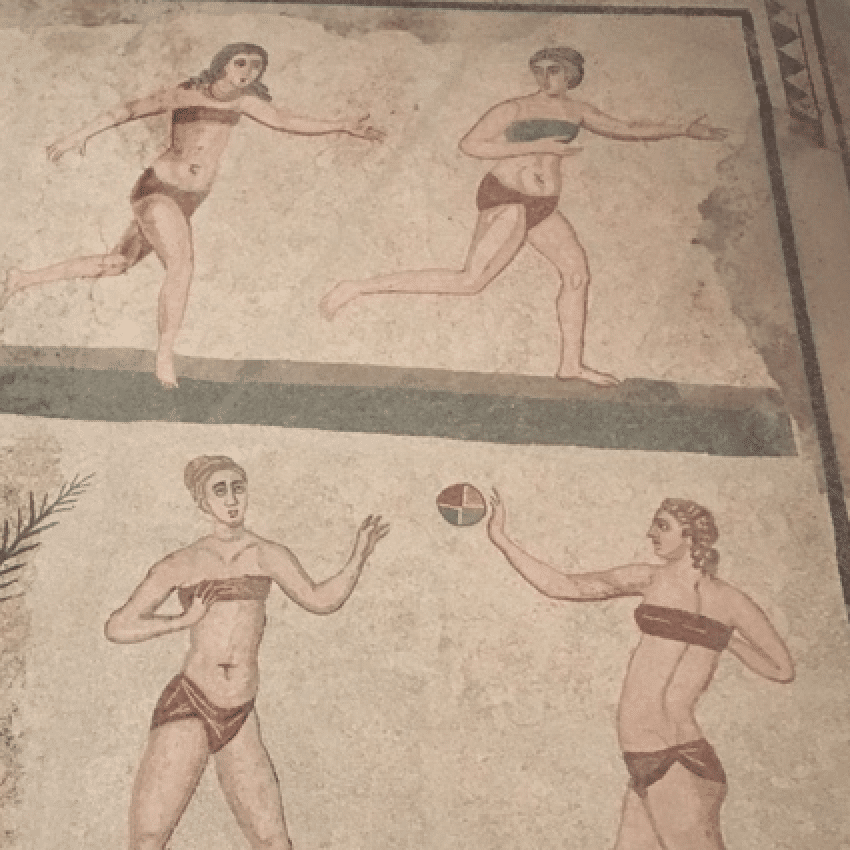 Women Athletes Mosiac, Villa Romana del Casale, Sicily. Photo by ConsumerMojo.com
Women Athletes Mosiac, Villa Romana del Casale, Sicily. Photo by ConsumerMojo.com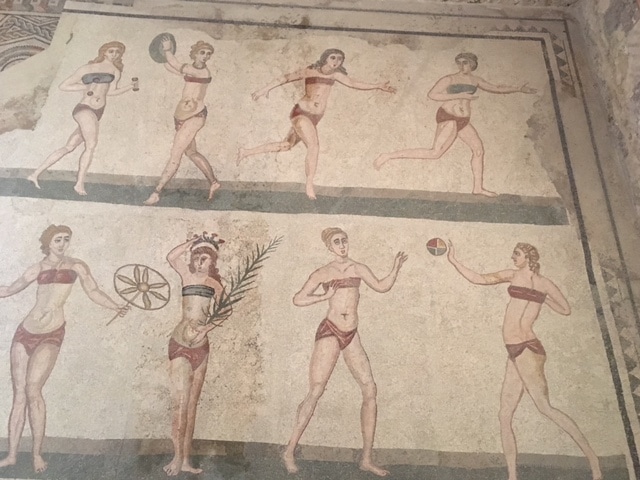
The mosiacs depict women athletes playing a variety of sports and a crowning ceremony for the victors.
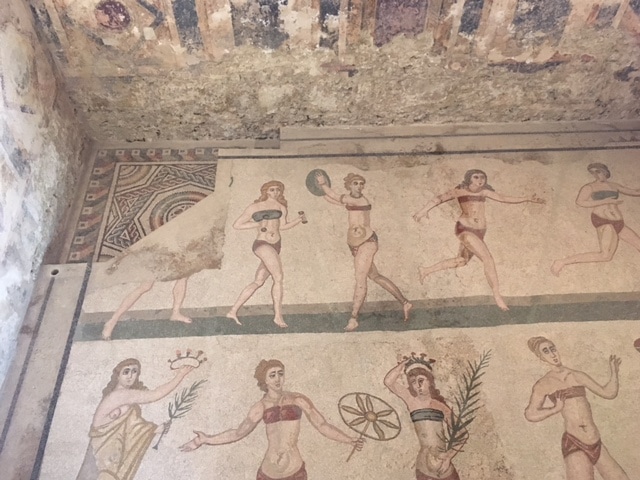
We went from scene to scene, pointing out details in each new beauty that we saw and delighting at the charm of the stories the artists depicted. It’s a must-see, not duplicated or even approached anywhere else.
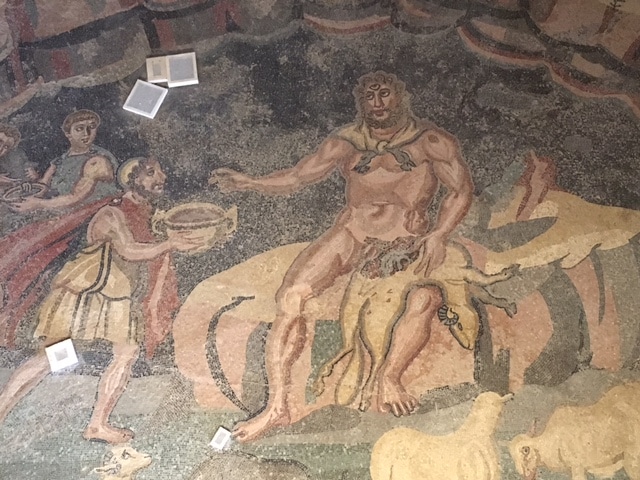
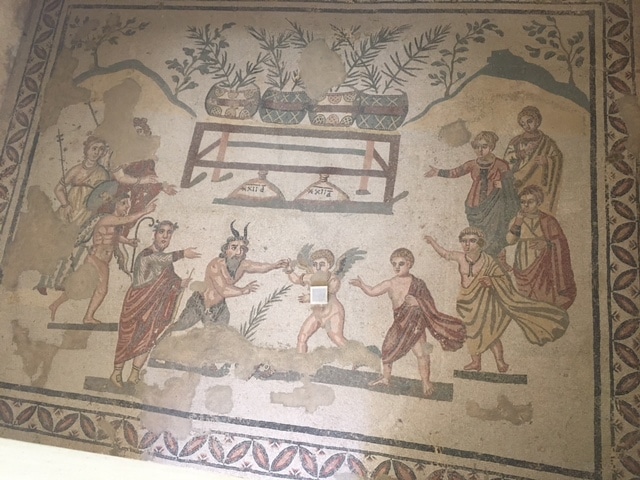
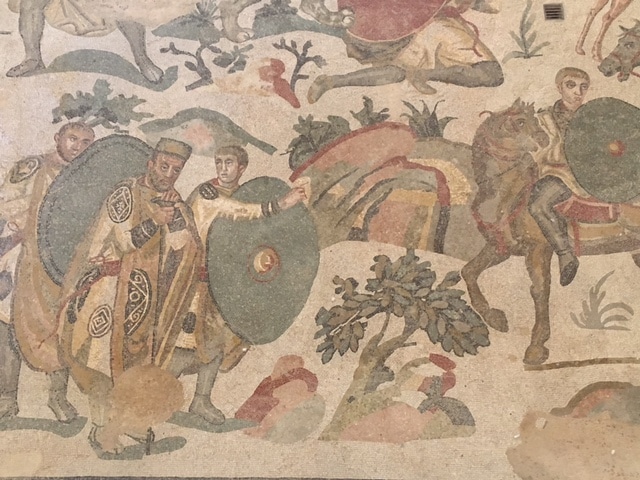
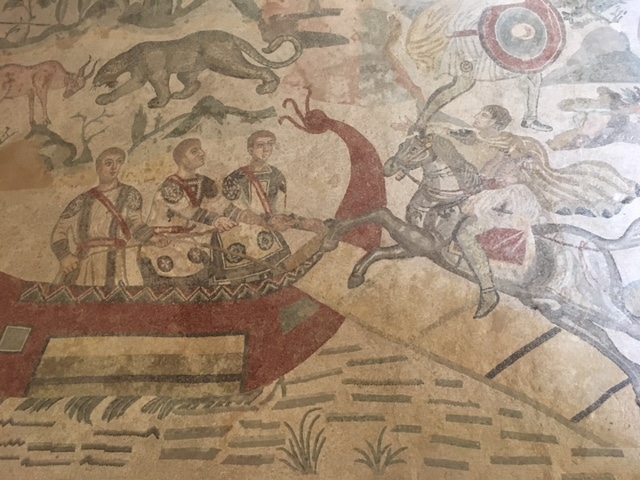

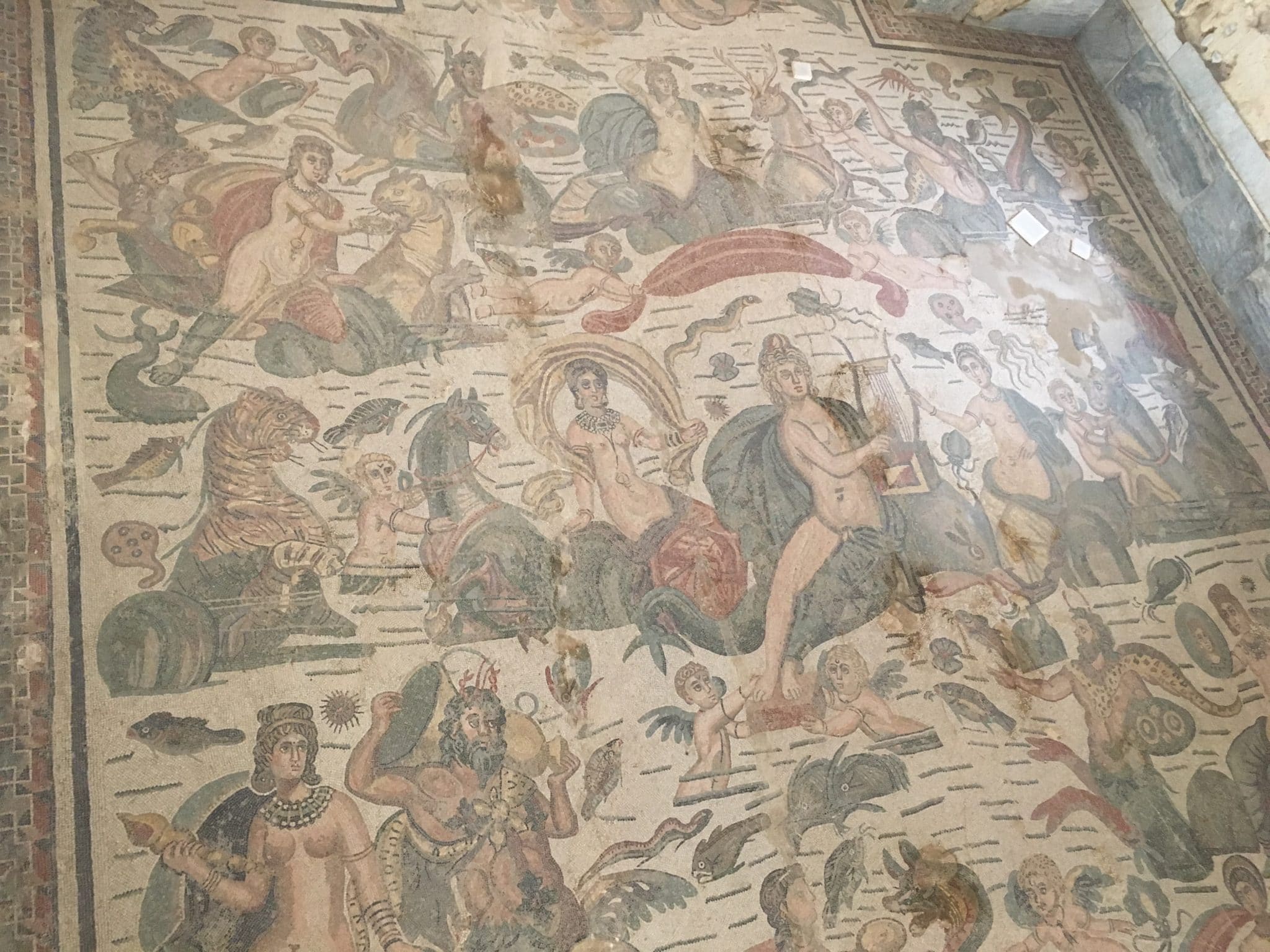
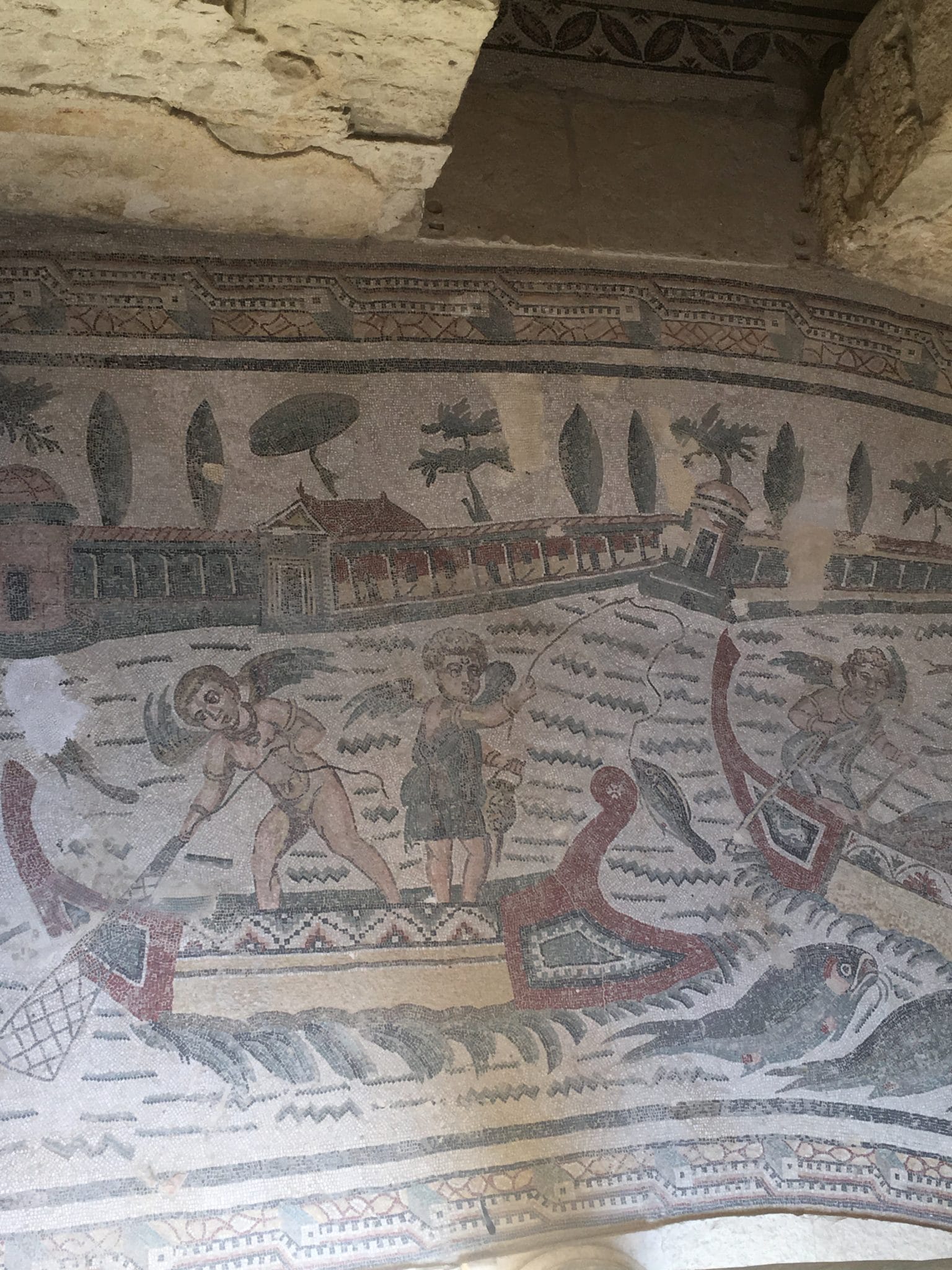
We wandered among the mosaics into the early afternoon. Then we grabbed a sandwich at the snack bar, tried (again without success) to program the car’s GPS, and headed west toward Agrigento and the Valley of the Temples.
Autostradas link Sicily’s major cities, but most of the secondary roads we used were good and we never saw much traffic.

Hertz’s throwback paper map was short on details but Barbara is great at asking directions regardless of language. It took us less than two hours to reach Agrigento via Caltanissetta and Racalmuto, a drive of about 100 kilometers.
We stopped on the outskirts to refuel. Barbara got out and her eyes widened. “Look!” she said, pointing to a temple on a hill that overlooked the highway. Now we really wanted to see more.
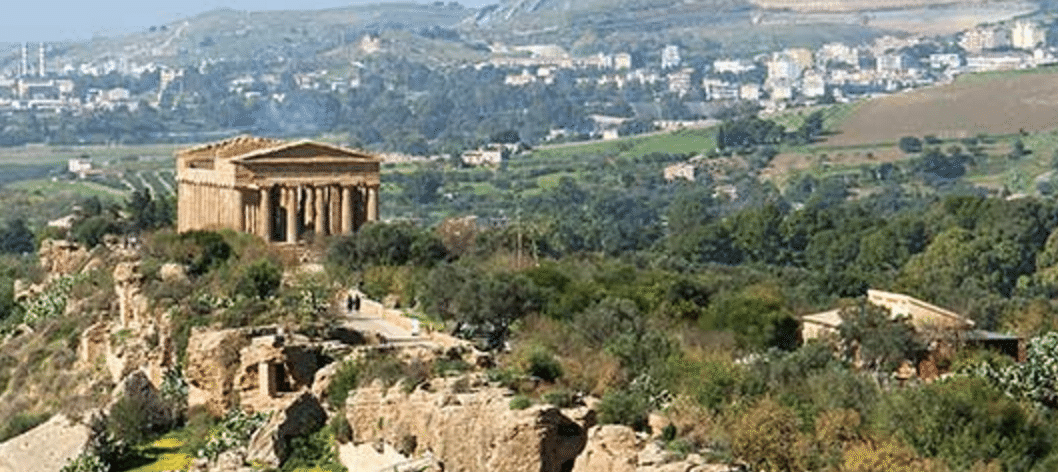
Greek mythology says Daedalus and his son Icarus founded Agrigento after they fled Crete. History tells us that Greeks from Rhodes and Crete settled Agrigento as a city-state in 580 BC.
The philosopher Empedocles was born in Agrigento, then called Akragas, in 490 BC. The four so-called “classical elements” — earth, air, water and fire — were his idea along with a fifth, the elusive and invisible aether. The temples, built with local sandstone, were underway when he was born. When he died, in 430 BC, seven Doric temples stood lined along a narrow ridge between the hills of Agrigento and the Mediterranean coastal plain.
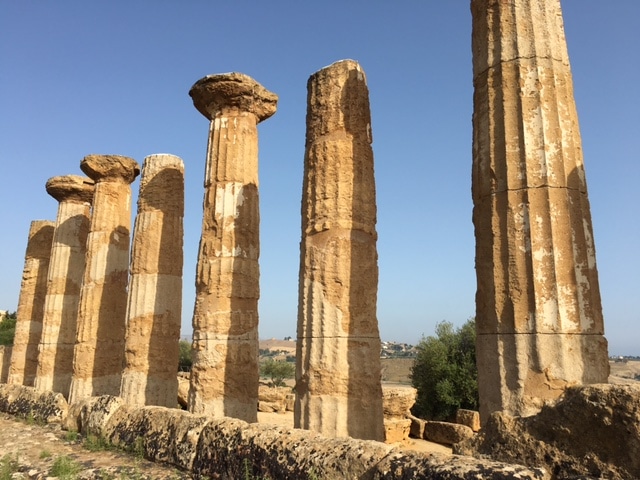
The city became one of the richest in the Mediterranean world. The poet Pindar called it “the most beautiful city mortals have ever built.” Despite wars of destruction and a succession of rulers from Goths and Vandals to Byzantines to Muslims to Catholics to Normans to Germans, Spanish, French and finally unified Italy in the 19th century, its beauty remains.
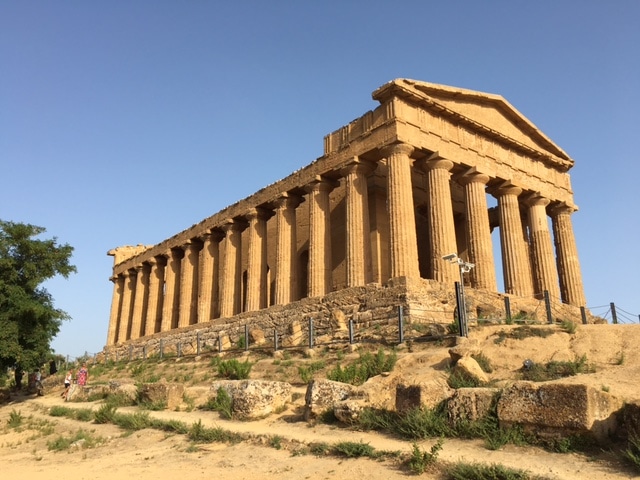
We passed the entrance to the Valley of the Temples on our way to the B&B friends recommended. But once we got into Agrigento’s narrow and confusing streets we naturally got lost. We finally called the owner and he came to rescue us.
Francesco Foti operates the Terrazze di Montelusa in a building his family has owned since 1820. He led us in his car along the switchy and ever-rising streets to the Piazza Lena and the B&B.
Francesco doesn’t live in the building, but two of his cats make their home in his office there. He’s posted signs on the doors warning not to let them out, but those two snoozing lumps of fur didn’t look interested in going anywhere. Francesco suggested it was too late to see the Valley of the Temples that day. He said we should go the following afternoon when we’d have more time.
So once we’d freshened up in our spacious room, we went out to get familiar with the old city of Agrigento.
A walk up a steep hill took us to the Monastery of Santo Spirito, which doubles as a B&B and where the nuns make famous sweets.
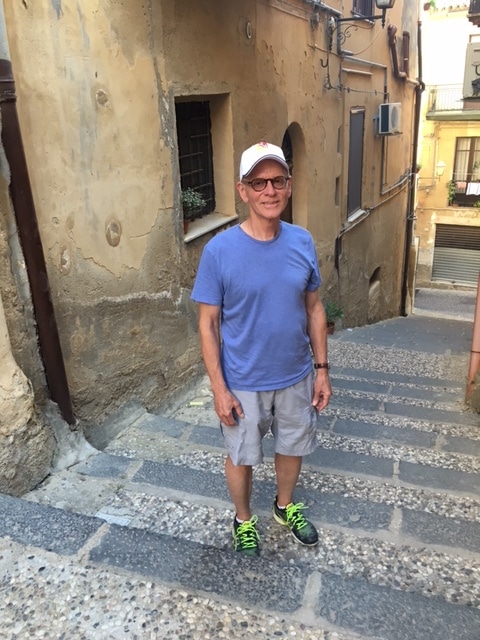
Nick Taylor on the steps in Agrigento, Sicily. Photo by ConsumerMojo.com
From there we followed stone stairs down to Via Atenea, a shopping street. From there more stone steps descended to streets with terraces overlooking the Valley of the Temples and the sea.
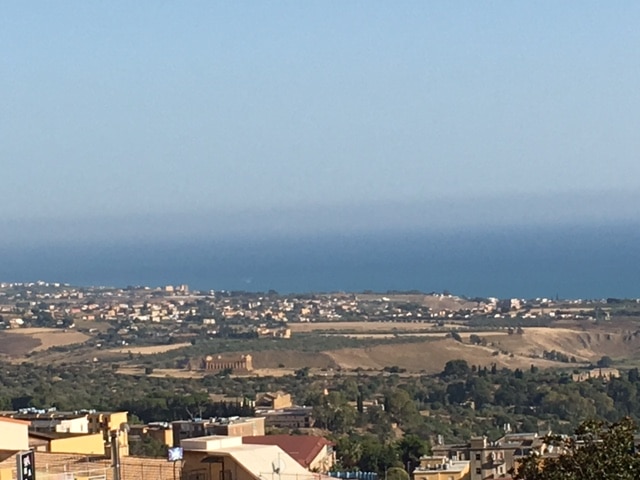
We found a restaurant that shared a piazza with the Chiesa di San Pietro (Church of St. Peter). There, we again found ourselves entertained by the comings and goings of a political gathering. Women in dresses and men in dark jackets, tieless white shirts and jeans stood around the entrance talking.
Inside, a speaker addressed an audience that filled the pews. He stood in front of a sign that implored “Dire di si!” or “Say yes!” Italy has its own brand of political gridlock, and then-Prime Minister Matteo Renzi launched the campaign to reduce the size of Italy’s Senate and change its power. Italians voted no that fall. But in 2019, the far right Five Star Movement, then the main party in the governing coalition, pushed a vote through parliament that reduced the number of MPs from 630 to 400.
While we learned about Italian politics, a server appeared and we said, “Yes!” to our usual vino bianco to cool us off in the summer heat.
That night we took Francesco’s recommendation and walked down the hill and around a corner and through a piazza named for playwright and native son Luigi Pirandello. We sat outside at Osteria ExPanificio, ordered the local white wine and shared a bowl of mussels. Then Barbara had casserole al pesto Trapanese with red shrimp and Nick stuffed calamari. Again we smiled through a meal and stayed until the servers began stacking chairs on the tables.
The following morning, Saturday July 9, we ate breakfast on the B&B’s terrace a floor up from the bedrooms. We paid Francesco 75 euros plus taxes and then he drove us with our luggage in his small car down to the garage to retrieve our car. The night of parking was free for his guests.
We had only a short drive to Villa Athena, by far the most expensive and most luxurious hotel of our trip. It’s a renovated 17th century villa with only twenty-seven rooms.
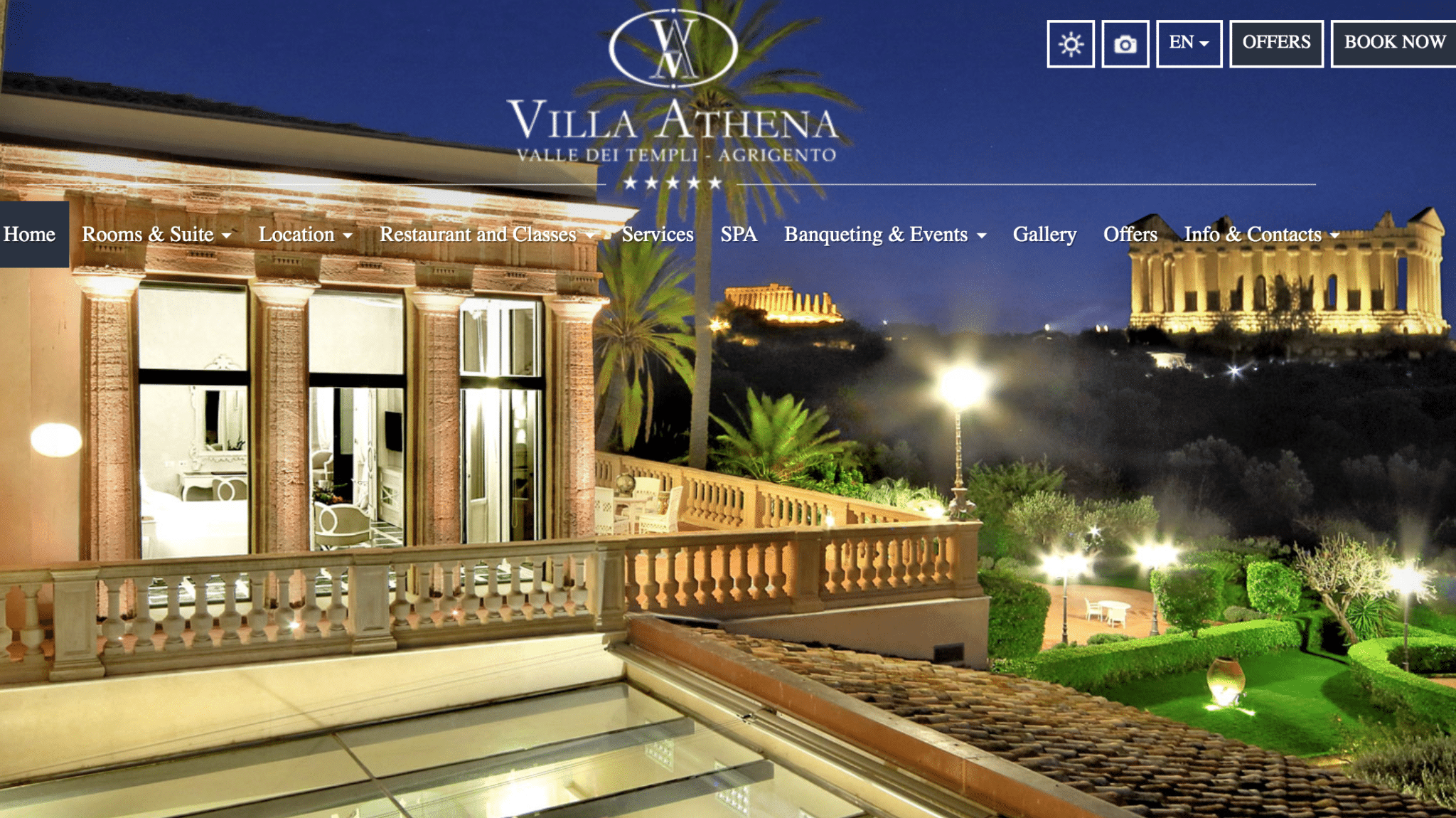
It lines up squarely with the Temple of Concordia, so close you felt you could reach out and touch it over the surrounding almond and olive trees.
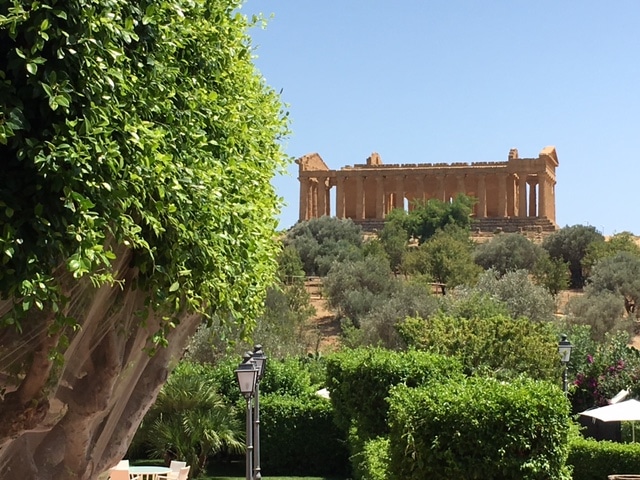
We arrived too early to check in, left our luggage and set out to explore the area around Porto Empedocle. We detoured from history here and ventured into the fictional world of Andrea Camilleri.
We’re big fans of the wry series he created featuring police inspector Salvo Montalbano. Camilleri used his home town of Porto Empedocle as the model for Vigata, Montalbano’s base of operations. So in a case of life imitating art, in 2003 officials changed the name to Porto Empedocle Vigata. They changed it back in 2009.
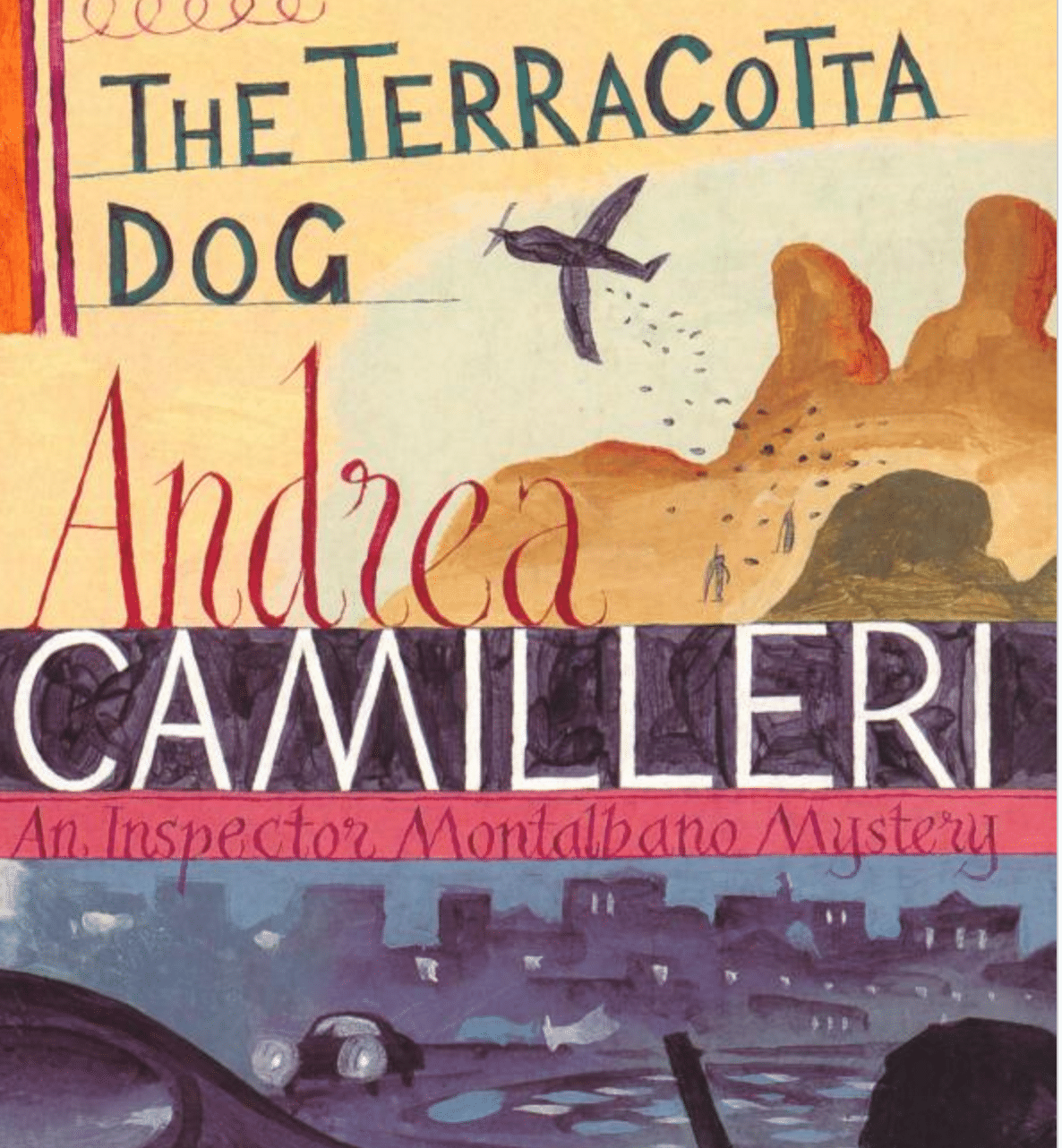
Camilleri was an inspiration, by the way. He was 69 when he created Montalbano and vaulted onto the best-seller lists. He continued working and produced more than twenty novels and a BBC television series. He died at 93 in 2019, a Sicilian national hero.
We rode through the port and followed the waterfront road where Montalbano, in Camilleri’s imagination, lives in a house by the sea and crime occasionally rolls in with the tide.
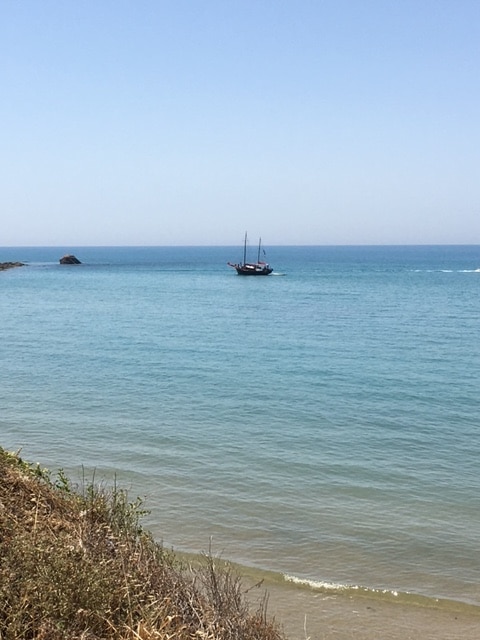
We passed beaches and beach clubs packed with people, but kept going. At Realmonte we turned toward the sea. The road dwindled and we parked and found ourselves above a pair of crescent beaches divided by a natural rock jetty.
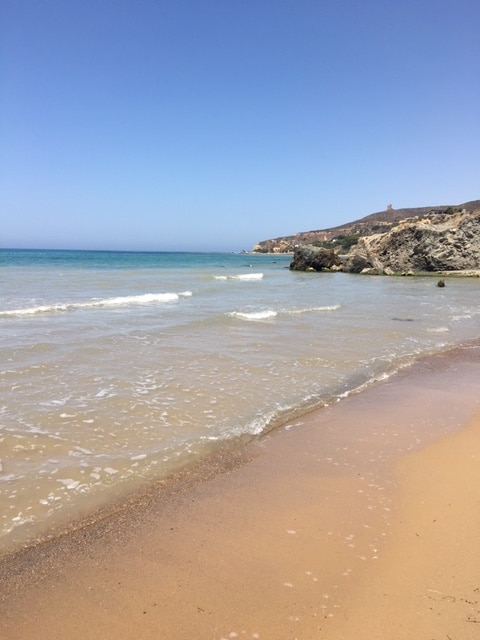
A few people sat on towels under umbrellas and a couple of small boats hugged the shore. We climbed down toward the water. Signs advised against swimming due to water pollution. But it was pretty.
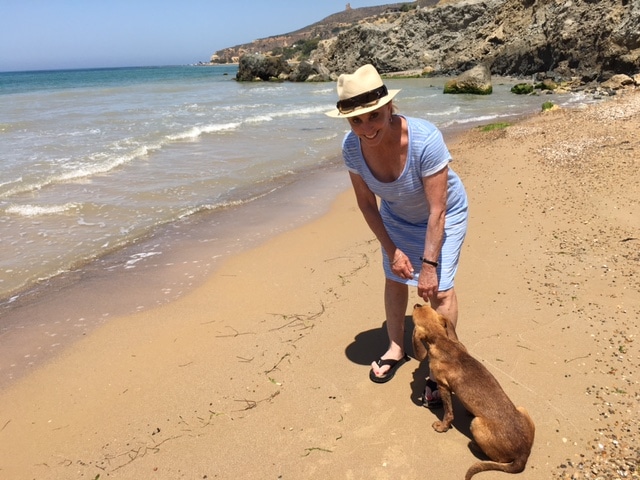
As we walked in the sand, a small brown dog introduced herself.
Soon we headed back through Porto Empedocle to San Leone, Agrigento’s beach town. Surprisingly, very few people came out to the beach on a Saturday afternoon.
We found a parking space and a machine to buy a parking ticket. Thinking it worked like New York’s, Nick put his debit card in and the machine swallowed it whole. Then somebody came along and said you didn’t have to pay for parking on the weekend anyway. He felt stupid but knew the card was gone so he only beat his head against a tree once.
We were diverted from the loss of the card when we walked through an amusement park on the beach.
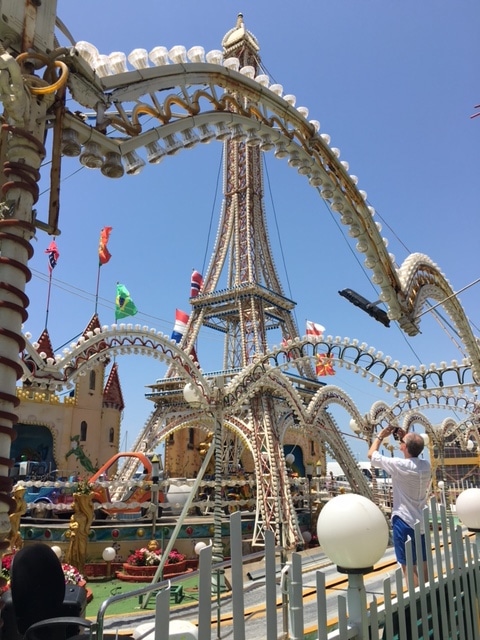
It had bumper car rides and a carousel and a pint-sized Eiffel Tower replica and workers lounging. Flags flew from the towers of a small fake castle. Weirdly, a Confederate battle flag flapped among them. News of American flag politics had apparently not reached San Leone.
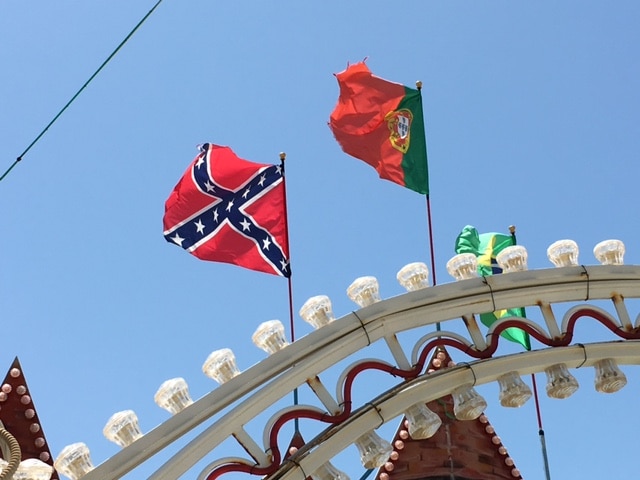
At lunch time, we joined locals at Trattoria Portobello at the end of a string of restaurants that curve along the beach road.

By now we had each consumed about eight feet of octopus tentacles and squid bodies in antipasti, pastas of all kinds, seafood mains, and been delighted every time. So we ordered calamari fritti, a seafood mixto salad and some spaghetti with tomatoes and basil to split.
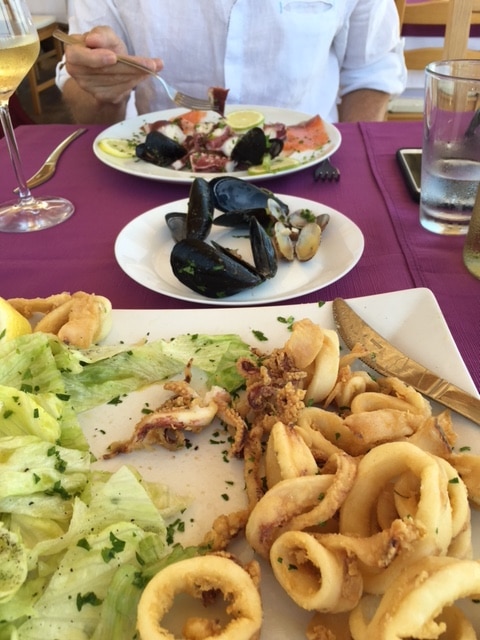
When we got back to the hotel, the desk clerk told us we’d been upgraded and showed us to a room whose small terrace looked onto the Temple of Concordia. The hotel’s inviting pool lay right below us and also looked toward the temples, so we couldn’t resist.
After a swim blessed by the Greek gods, we took our Sicilian nap and awoke in time to make it to the Valley of the Temples by 4:30. People say the best time to visit the temples is in late afternoon and early evening when the light is golden. We arrived when the sun was high and hot and the sky a cloudless blue. We still had not seen a cloud over Sicily.
The temples are part of an archaeological park that also contains thousands of almond and olive trees. At the parking lot, you have two options. You can take a taxi to the Temple of Juno at the park’s far end and give yourself a one-way tour back to your car. Or you can do what we did, walk into the park where we were, at its western end.
This led us first to the ruins of the Temple of Jove. Even the wreckage — huge columns and hewn stones strewn about over a wide area — conveyed grandeur. Beyond it to the west stood the four remaining upright columns of the Temple of Castor and Pollux. But more eye-catching ruins lay farther to the east.
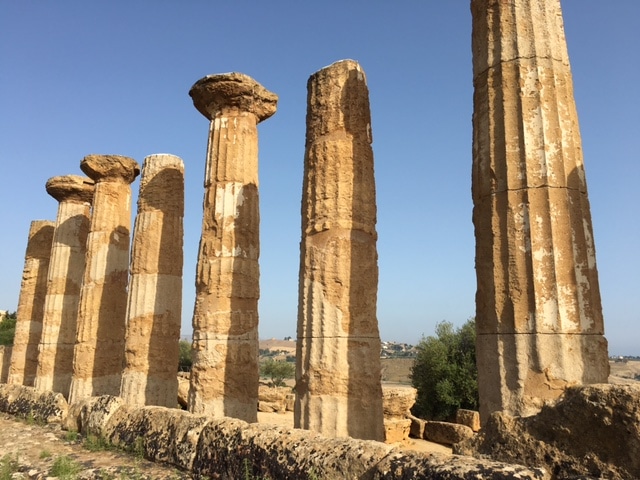
Next, we stopped at the Temple of Heracles (or Hercules). Of its original columns only eight are standing. Somehow we had entered this site from the back side and climbed into a restricted area, as we learned when a park employee took our picture and ordered us back to the right side of the ropes.
Now we joined a wide paved path that followed a slight upgrade to the Temple of Concordia.
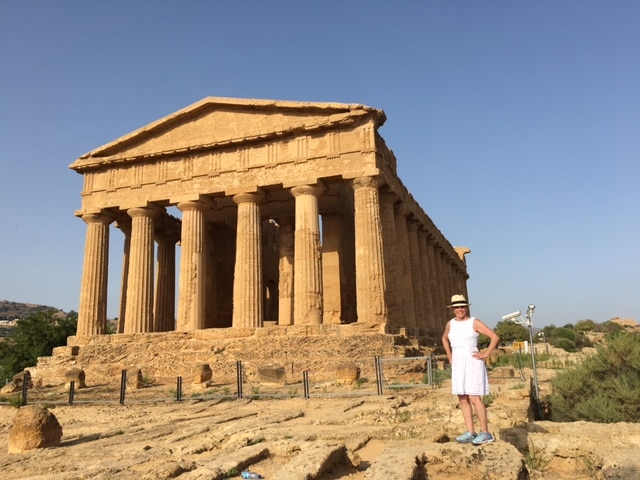
It’s the best-preserved of the valley temples, mainly, we’re told, because of interior arches that were added later when Christians used the temple as a church. With its fluted columns — thirteen long and six wide — upright and intact, and its entablatures above still whole as well as the crowning pediments at each end, you could almost imagine it was still in use.
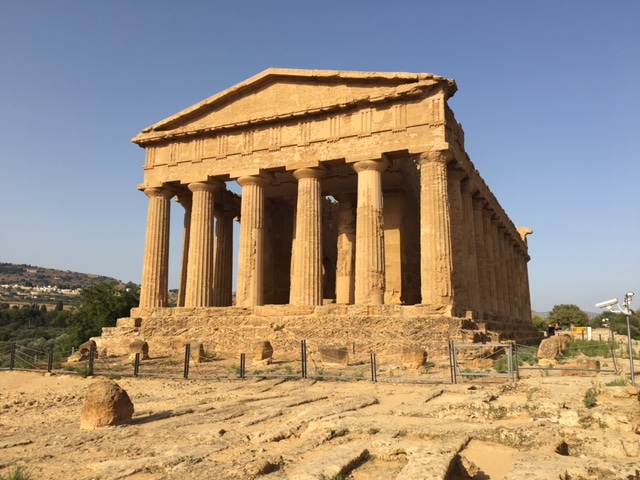
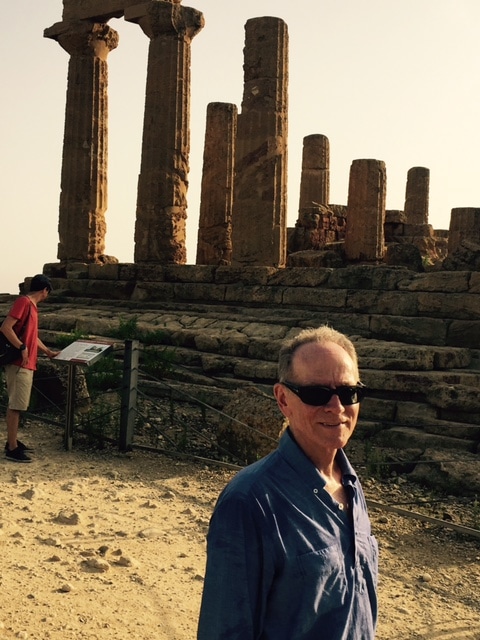
What remains of the Temple of Juno is mostly standing columns and a few remaining pieces of entablature. Juno being the Roman name for Hera, the Greek goddess of love and marriage, the newly-married like to have photos taken here.
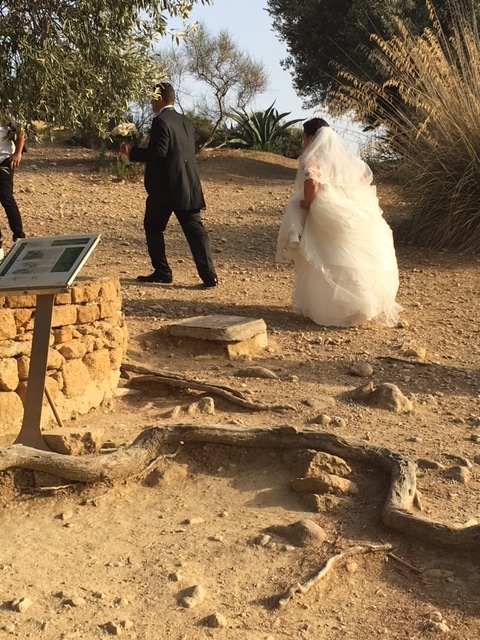
We saw several decked-out wedding parties posing at the site to preserve their memories under the smile of the Greek goddess.
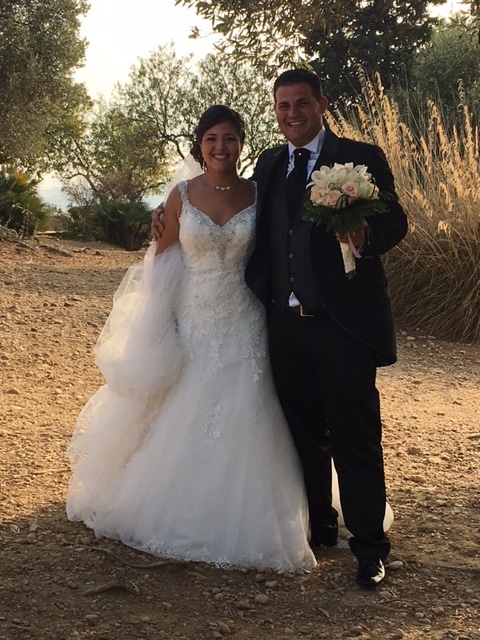
Smiling bride and groom in the Valley of Temples, Agrigento, Sicily. Photo by ConsumerMojo.com.
Before moving on, we struck up a conversation with a park security guard who had lived in New Jersey for awhile, and whose daughter works as a cop in Totowa. He told how much he missed New Jersey and New York and good Chinese food.
On the walk back, we spotted an enclosure with exotic long-haired white goats with twisted horns that looked as if you could use them to drill a hole.
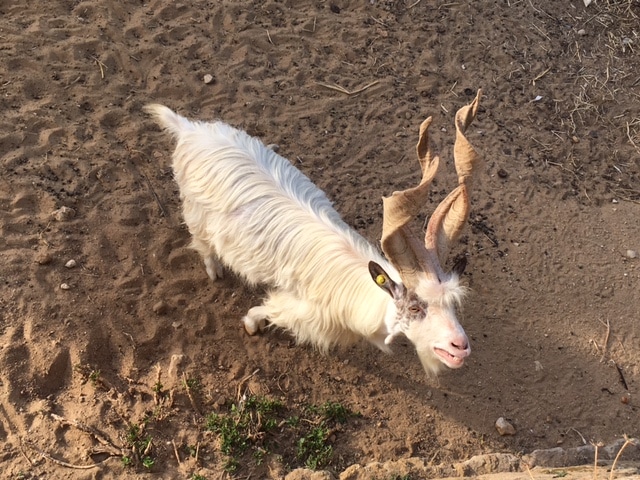
A placard explained that these Girgentana goats, while native to Agrigento, are thought to have originated in Afghanistan or Tibet and were brought to Sicily by Arabs when they ruled the island. There’s a growing movement to keep the endangered breed alive because their milk makes great goat cheese. In the meantime, the park hopes that people will contribute money to maintain them.
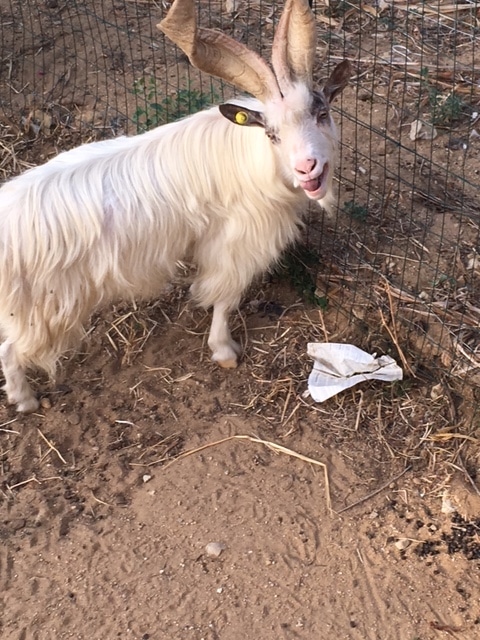
We returned to the Villa Athena and toasted the view from our terrace with a couple of glasses of prosecco and watched a rush of chirping birds descend on the trees as twilight eased in. The birds made a racket for about five minutes and then as suddenly as it began, the chirping stopped when they settled down for the night.
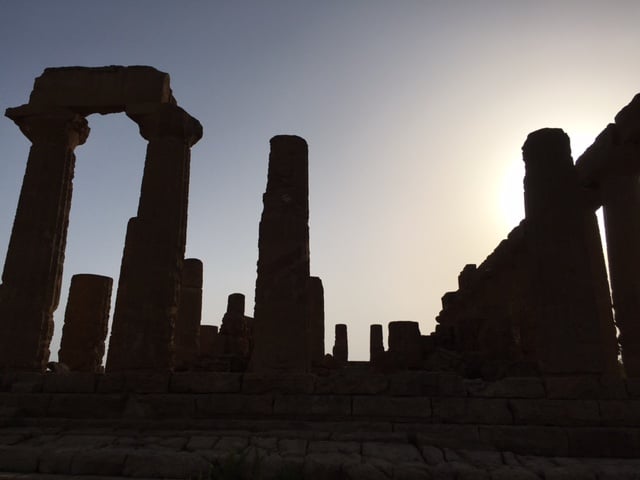
We couldn’t resist dinner at the Villa Athena’s restaurant.
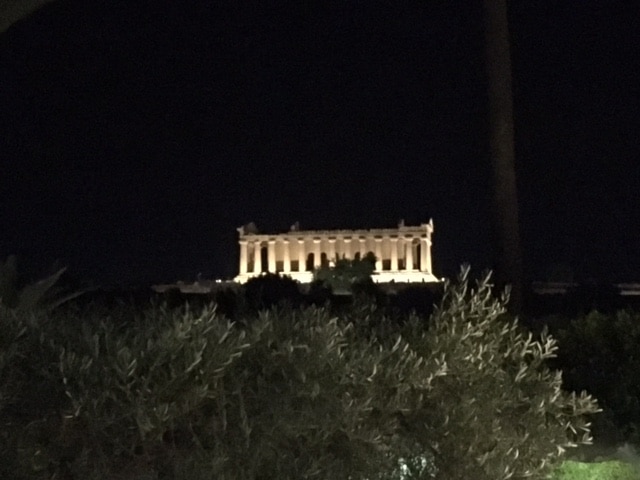
From our table at Terrazzo degli Dei we had another fine view of the Temple of Concordia, now dramatically lighted in the dark.
Nick had a first course of spaghetti in a shrimp, pork cheek and Girgenti goat butter sauce. Barbara ordered eggplant gnocchi with octopus, potato and thyme. The wine list offered a reasonably priced Mūller-Thurgau from Erice in western Sicily. That’s where we would head next.
We chose a fresh whole red snapper from the fish cart wheeled to our table and ordered it grilled.
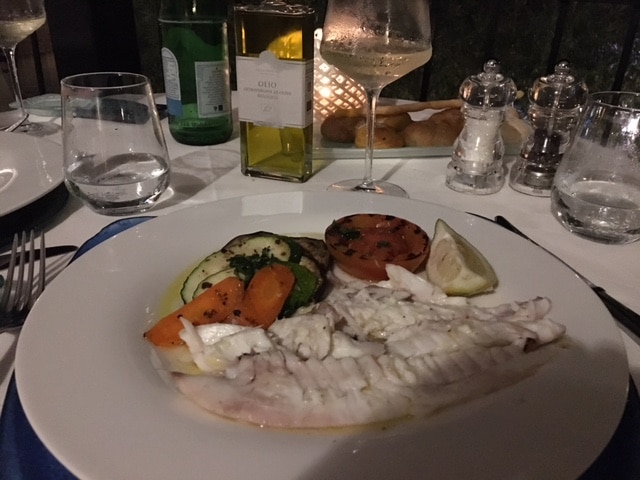
In love and feeling the bliss of another wonderful meal, we went to sleep smiling.
The next day, Sunday July 10, we took a quick morning swim, said a reluctant goodbye to the Villa Athena and headed west along Sicily’s southern coast.
Less than an hour later we reached Sciacca and left the highway to take a look.
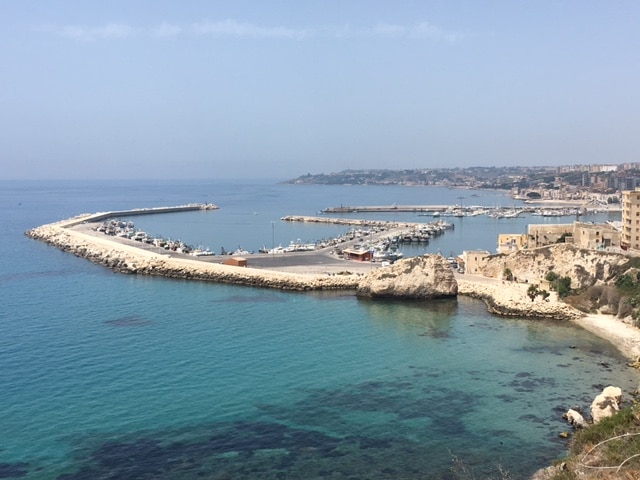
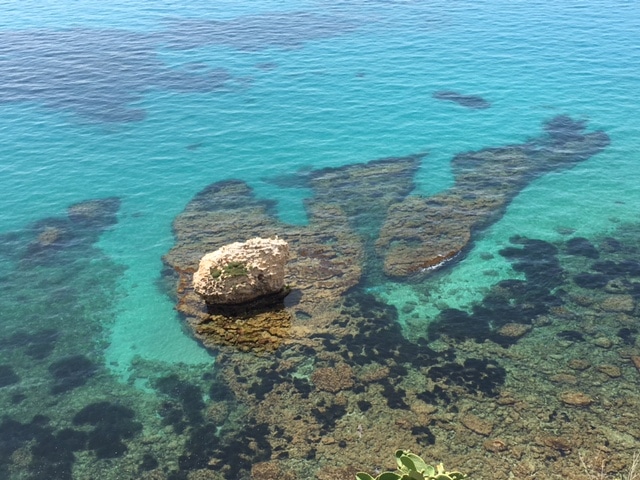
We wanted to see it because we knew New York City fishmongers whose families came from there. Nick wrote about a feud in one family from Sciacca that played out in our neighborhood on Bleecker Street. The story appeared in New York magazine. While that was in the 1980’s, you can still read: Blood Feud on Bleecker Street.

We drove down steep streets to the harbor, passing men drinking coffee and playing cards at outside tables and we had to take photos here.
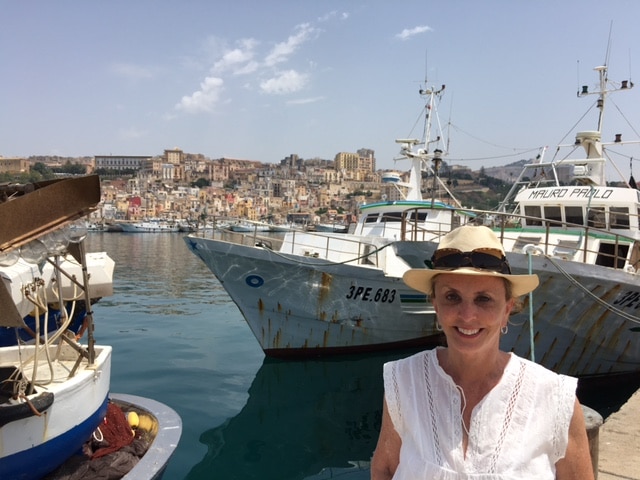
When the local road narrowed and closed in at the far end of town Nick realized we had gone too far on the sea road. There was no room to turn around. His maneuverings terrified a bevy of Sciacca housewives on their apartment balconies worried about damage to their cars or property. Barbara got out of the car to guide as he backed up inch-by-inch to turn around.
A sigh of relief and we headed back to the highway. We drove another 36 kilometers to Selinunte (or Selinus), once an important Greek colony in Sicily where more temples cluster close to the Mediterranean.
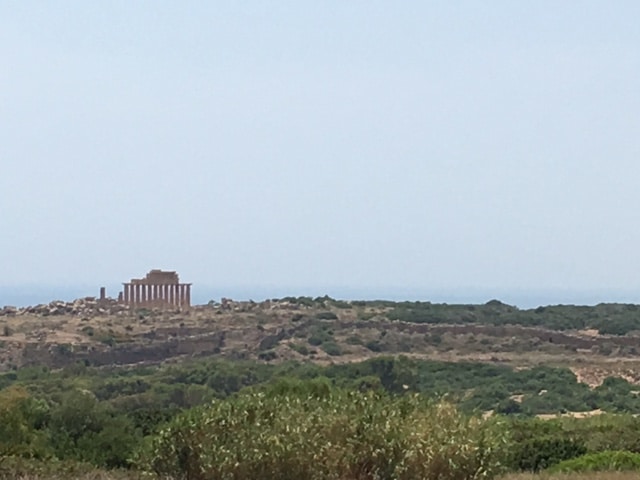
Wars with Carthaginians in the fourth and third Centuries B.C., destroyed the city and yet a haunting beauty remains.
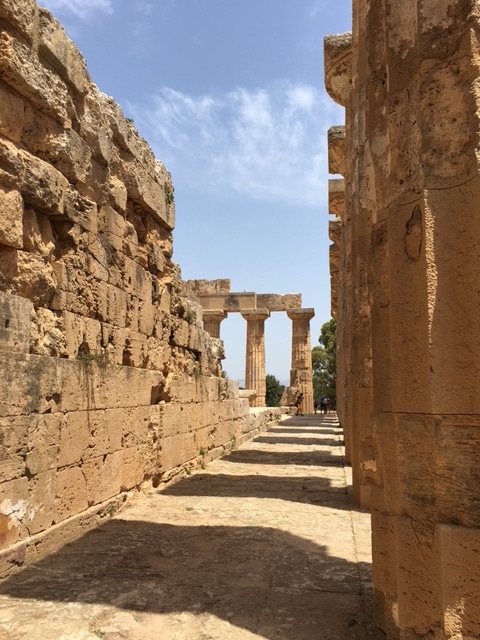
Partly reconstructed Temple E, or the Temple of Hera, wasn’t roped off so we climbed the steps and walked around.
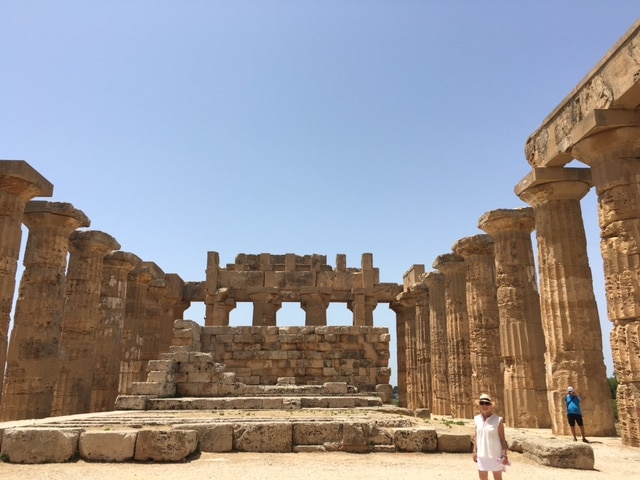
An unreconstructed temple on this site, known as Temple G and dedicated to Apollo or maybe Zeus, at some 330 feet long was one of the largest temples the Greeks built anywhere.

From Temple E we could see in the distance toward the sea the Acropolis of Selinunte. Of its three temples, only one row of columns remains standing amid a lot of fallen stones. We could have seen much more at Selinunte but the road was calling. We still had kilometers to go.
All photos and videos shot with our iPhones.
